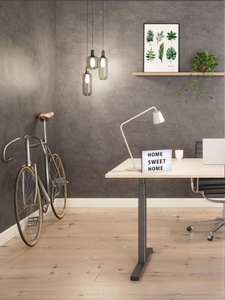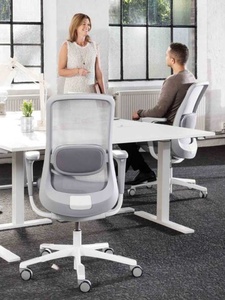The popularity of sit-stand working has grown dramatically in the last few years however with the variety of options out there it can be difficult to decide which is the right option for your needs.
KOS Ergonomics are a team of ergonomic consultants who have being providing sit-stand solutions and sit-stand desks for over 19 years. We are sit-stand experts and are very particular about what sit-stand solutions we take on to our range.
When looking to incorporate more active working into your office it is important to consider a variety of factors to ensure you select the right option and can achieve your goal effectively. Have a look at our Ultimate Guide to Sit-Stand Working to do just that!
Benefits of use
Before you consider a Sit-Stand solution it's important to understand how your health will benefit from their use. When we remain in the same position for long periods of time there is a build-up of static strain on muscle.
This has been shown to be more tiring than dynamic loading of the muscle. A build-up of fatigue in the muscle results in poorer postures being adopted meaning slouching, rounding of the shoulders, leaning over and more. The end result unfortunately tends to be somewhere along the spectrum of discomfort, pain and serious injury.
Sit-Stand Desks allow for ease of movement between working positions. This means a user can maintain a healthy posture for shorter periods. For example, when they feel their posture deteriorating while sitting and they begin to slouch and round the shoulders they can simply change to a standing position and avoid the detrimental effects of maintaining a poor posture!
Being proactive about posture and work-related health is vital in maintaining longevity and increasing productivity.
A Desk or a Desk Top Adapter?
So you’ve decided you want the option of standing while you work. But where do you start? Nowadays when making changes to their space many organisations will opt for sit-stand desks for all employees.
When combined with education on how and when to use the desks this works really well.
Sit-Stand working helps to;
- Improve employee productivity
- Improve office morale
- Minimize employee discomfort
- Encourage a more active work environment
Sometimes companies will elect to have some hot desks around the office or a couple on each floor. This way employees can make benefit of changing their working position and those people who enjoy working while standing are accommodated.
An option many aren't aware of is the desk-top sit-stand adapter. These are an excellent option for situations where space may be a consideration or if the organisation has all fixed height tables and would like employees to have the option of alternating between sitting and standing!
Desk-top adapters are easily transferred from desk to desk also so if an employee leaves the organisation their adapter can be moved to a colleague's workstation. Adapters can be manual or electric. For those with some lower back pain or discomfort the electric option like the KOS Standesk may be the best option so as not to aggravate any pre-existing injuries.
Ease of adjustment
The best sit-stand workstation needs to be easy to adjust, otherwise it won't be adjusted and you the user won't get the true value of using one. Ease of adjustment is a crucial factor to consider when deciding what option to go with. KOS Ergonomics are selling sit-stand desks for 19 years and have had all types of mechanisms over the years.
A) Electric Sit-Stand Solutions
Simply press and hold a button until the desk reaches your desired height and hey presto your being proactive with your back health. The ease of adjustment is second to none and the movement of the desk itself is extremely smooth. There is also no manual handling risk and they can hold large weights. Some options also come with a memory setting like the KOS Standesk sit-stand adapter! This means the user can alternate between sitting and standing with the single touch of a button.
B) Crank adjustment sit-stand solutions
Crank adjustments require the user to wind the desk up and down which becomes tiresome for the user and eventually usage reduces. They were very popular in the late 90's however the fact that the user potentially doesn’t vary their posture as much as they would if the method of adjustment was easier means they don’t get the true value from the desk.
C) Counter-balanced or gas assisted sit-stand solutions
These options are very quick and easy to adjust provided they have the perfect amount of load on the desk. If there is too much load the desk begins to lose stability, or the height may unintentionally drop. There may also be a manual handling risk when lifting the sit-stand desk, if there is too much weight on it.
If there is not enough weight or the resistance is set to stiff, the sit-stand desk can shoot up too quickly and can be very difficult to push downwards, particularly when raised above elbow height. This makes it very difficult to adjust, particularly for the shorter user and there is a risk of injury while doing so. Counter-balanced mechanisms are generally only recommended if there is no access to electricity and the loads put on the desks are consistent.
Height Range
The best sit-stand desk needs to have a large height range to suit the taller and smaller user in both the sitting and standing position. European Standards require a height range of at least 650mm-1250mm but our desks generally exceed this. If a standing does not have this height range the desk will not go low enough for the shorter user while seated and the desk will not go high enough for the taller user while standing.
Stability
The best test of a sit-stand desk is to raise it to its very highest and see how stable it is. This is linked with build quality. If the desk is unstable in the standing position it will be annoying and reduce the likelihood of usage. Also, that instability means parts are moving that aren't meant to be moving, so this is going to increase the likelihood of a breakdown or failure significantly. If possible, try out the sit-stand desk before buying to test the quality!
Accessories
A sit stand solution is an excellent option for an ergonomic workstation. However if other factors in the workstation result in an increased risk of injury then it is only a part of the solution.
A monitor arm is an excellent option for those with limited desk space. Along with the freeing up of space, a monitor arm raises the monitor to eye level with ease which will result in a neutral head position and reduced risk of upper back or neck injury.
Although the majority of work tends to be done on monitors in the current work environment paper work is still quite prevalent. The tendency for people who are more paper based is to lean and twist over when interacting with documents. A document holder like the Micro desk is an excellent option to ensure the user remains upright and doesn't develop any issues from repetitively interacting with paper. The sleek and sturdy design means they are a practical accessory for the standard office worker.
Other points of interest
Dynamic Load capacity - For a two-legged frame, it is always recommended to have a load capacity of at least 100kg+. KOS Ergonomics always try to have sit-stand desks with a dynamic load capacity of at least 130kg because people will treat the sit-stand desk the exact same way they will treat a standard fixed desk. They will lean and sit on it. Also there is likely to be a significant amount of weight on the sit-stand desk. For light use areas or where space is tight, a single leg sit-stand desk may be suitable. A load capacity of 70kg would be suitable but with a word of warning.
Energy Usage - Electrically Height Adjustable Sit-Stand desks use electricity but how much they use varies significantly. Our Scandic-Desk range uses on average 1/3 of the electricity on stand-by compared to the average sit-stand desk.
Anti-Collision - If you're looking for the best standing desk, I think anti-collision sensors needs to be included. When they come into firm contact with an object, the desk height reverses in height in order not to crush or damage furniture or a person. I think it's a must, if we really are talking about the "best" sit-stand desk!
Cable Management - There's nothing that annoys me more then untidy cables and there all more visible when the desk can adjusted in height up to standing level. Effective Cable Management is a must, so always get a cable tray and cable sock with your sit-stand desk!
As we become more of an active workforce, sit-stand working will continue to play a key role in managing work related discomfort, improving employee morale and productivity in the office. For every office space there are various options to aid with the introduction of sit-stand working. If you are still unsure which is the right option for you why not come into our showroom to meet one of our Ergonomic Consultants. Here you can try the different options, feel how the mechanisms work or see whether the manual or electric adapter would be best for you!
Our consultants take a variety of factors into account to help you identify with confidence which solution will be the perfect fit for you.
****************************************************************************************************
For more information regarding workplace ergonomics or to chat with one of our Ergonomic Consultants get in touch on 01 6110200 or email sales@kos.ie















